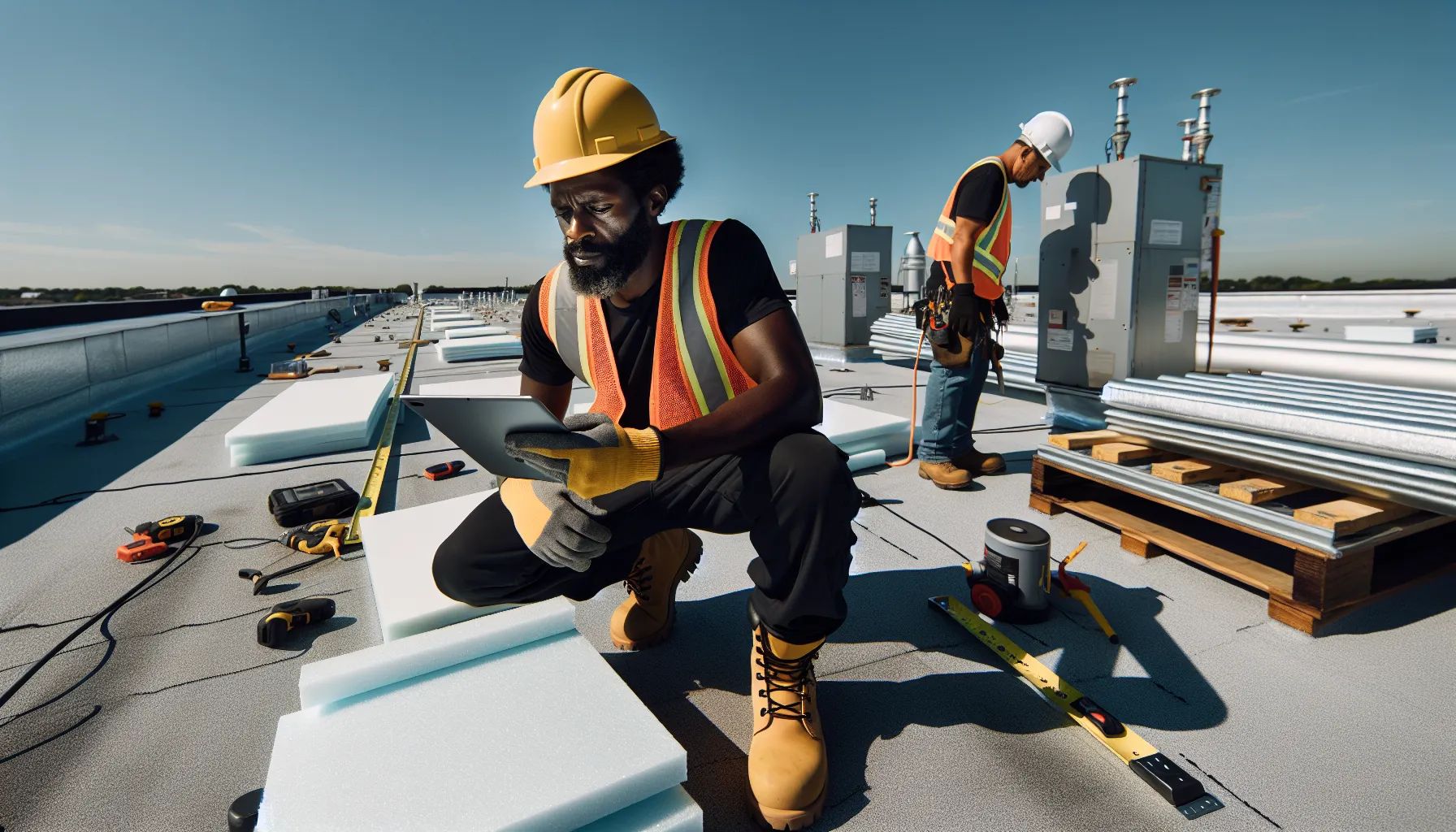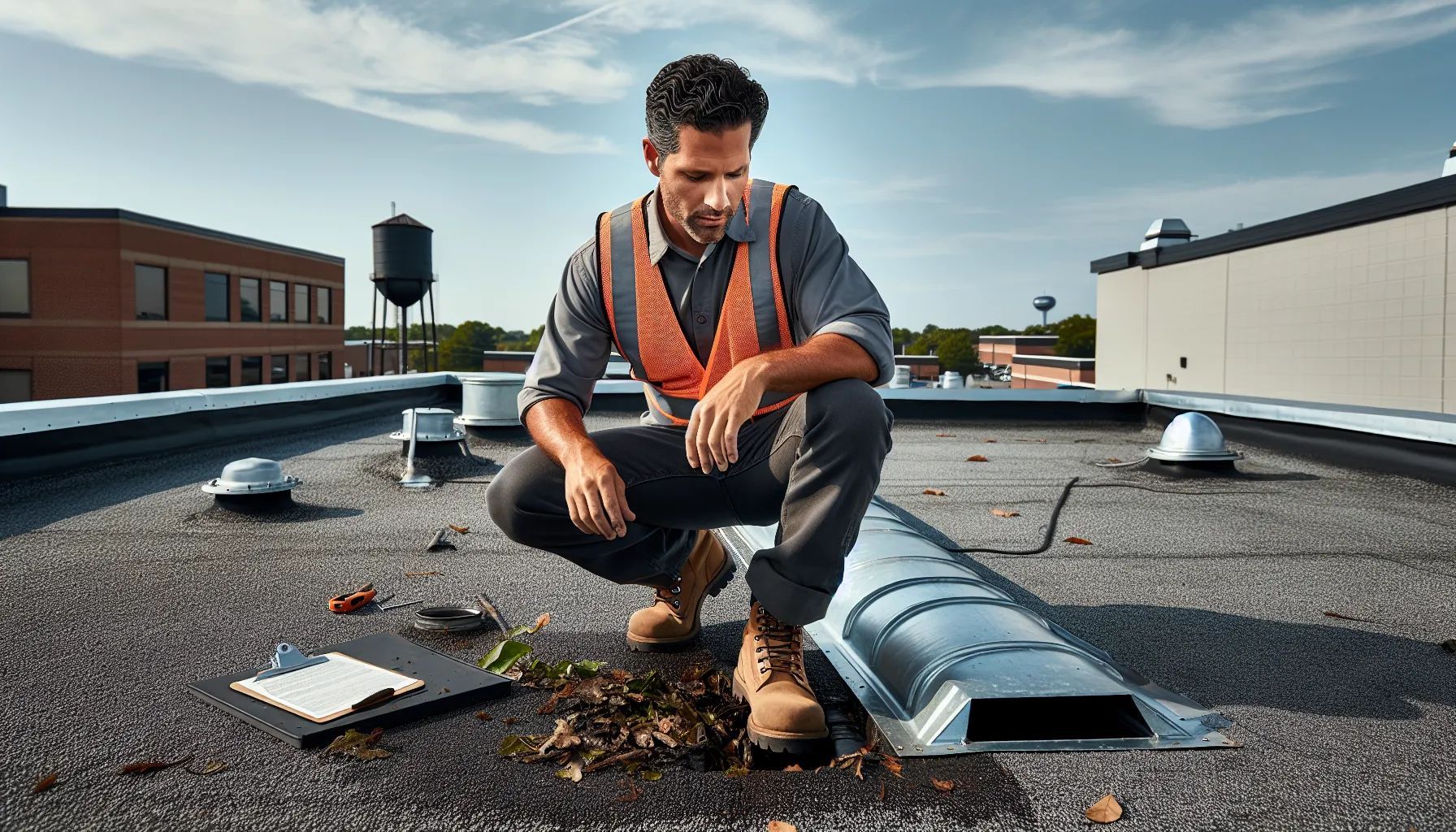Why Moss and Algae on Your Roof Can Cost You Thousands
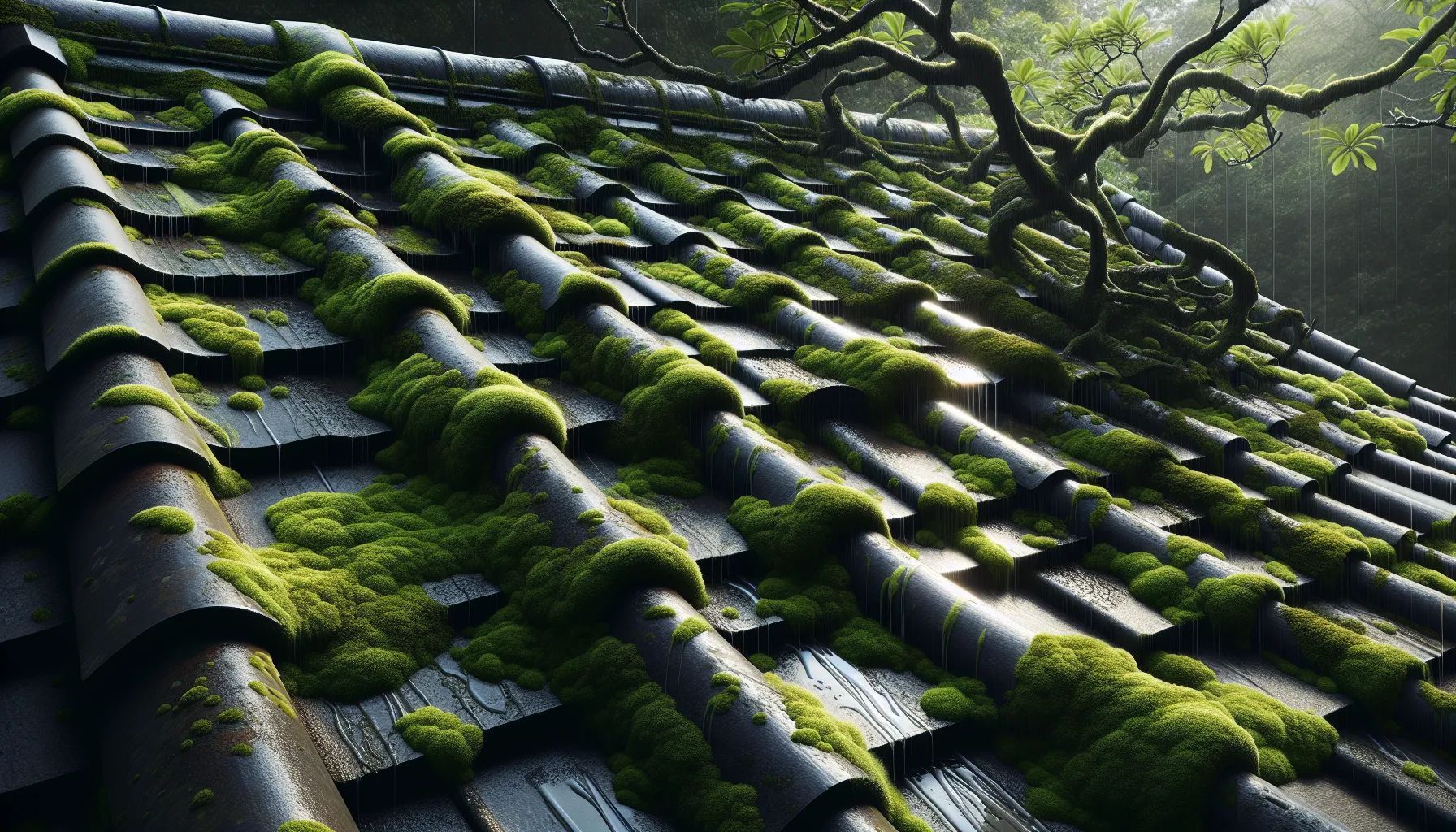
Have you noticed green patches spreading across your roof? We've seen countless homeowners struggle with moss and algae on roof surfaces without understanding the real damage they're causing. These organisms might seem harmless but they're secretly wreaking havoc on your home's first line of defense.
What starts as a minor discoloration can quickly escalate into costly repairs and potential health hazards. We'll reveal why these unwelcome guests choose your roof as their home and the surprising factors that encourage their growth. More importantly we'll explore the hidden consequences that most homeowners don't discover until it's too late.
Whether you're dealing with a current infestation or want to prevent future problems understanding the science behind roof moss and algae is crucial. We've compiled everything you need to know to protect your investment and maintain a healthy roof for years to come.
Understanding Moss and Algae Growth on Roofs
Moss and algae establish themselves on roofs through specific biological processes that homeowners often overlook. These organisms require particular conditions to colonize roofing materials and spread across surfaces.
Common Types of Roof Moss and Algae
Three primary moss species dominate residential roofs across North America. Bryum argenteum (silver moss) appears as gray-green patches measuring 0.5-2 inches thick on shaded roof sections. Ceratodon purpureus (fire moss) creates reddish-brown carpets up to 3 inches deep near roof edges and valleys. Hypnum cupressiforme (sheet moss) forms dense yellow-green mats that trap 40% more moisture than other species.
Gloeocapsa magma represents 85% of roof algae infestations nationwide. This blue-green algae produces dark streaks averaging 2-6 feet long on asphalt shingles. The organism's protective outer coating contains metallic granules that create characteristic black stains visible from ground level.
Chlorella and Trentepohlia algae species account for the remaining 15% of roof infestations. Chlorella produces bright green patches in circular patterns while Trentepohlia creates orange or rust-colored streaks on metal and tile roofs. Both species multiply rapidly in humid climates where monthly rainfall exceeds 3 inches.
Why Moss and Algae Grow on Roofs
Roofs provide ideal growing conditions through moisture retention and organic debris accumulation. North-facing roof slopes receive 70% less direct sunlight than south-facing areas creating persistent dampness. Tree coverage reduces UV exposure by 60-80% while dropping leaves and twigs that decompose into nutrient-rich substrates.
Environmental factors accelerate organism growth rates significantly. Humidity levels above 65% double moss reproduction cycles from 8 weeks to 4 weeks. Temperature ranges between 60-80°F optimize metabolic processes for both moss and algae species. Areas receiving less than 4 hours of daily sunlight experience 3x higher infestation rates than exposed sections.
Signs and Symptoms of Moss and Algae Infestation
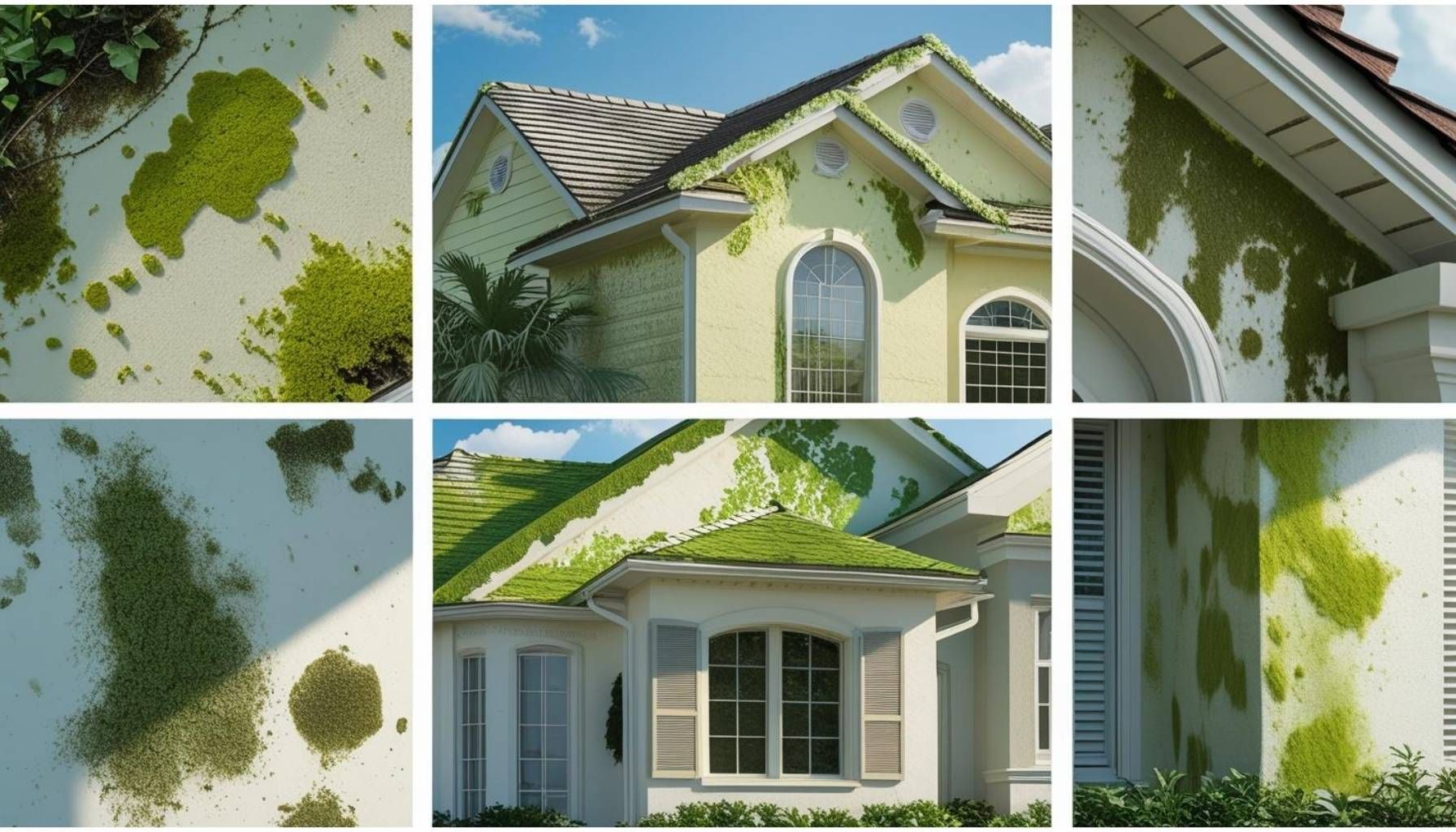
Recognizing moss and algae on your roof starts with understanding their distinct appearances and growth patterns. We'll examine the specific visual cues that indicate these organisms have colonized your roofing materials.
Visual Indicators to Watch For
Moss presents as a thick green carpet covering roof surfaces. The growth concentrates in shaded areas where moisture accumulates throughout the day. Moss colonies develop between shingles and along roof edges where water drainage slows. The texture resembles velvet or thick carpet pile reaching heights of 1-3 inches in mature colonies.
Algae manifests differently through dark streaking patterns. Black streaks run vertically down roof slopes following water flow paths. The discoloration ranges from charcoal black to brown grey or blue-green depending on the algae species present. Gloeocapsa magma creates the characteristic black streaks affecting 80% of algae-infested roofs across North America.
Physical changes accompany both infestations. Shingles beneath moss colonies lift at edges creating gaps for water infiltration. Algae growth causes granule loss on asphalt shingles exposing the underlying mat. Both organisms trap moisture against roofing materials accelerating deterioration rates by 40% compared to clean surfaces.
Early vs. Advanced Growth Stages
Early moss growth appears as small green spots measuring 1-2 inches in diameter. These initial colonies form within 6 months of spore settlement in favorable conditions. The spots connect over 12-18 months creating larger patches. Early algae growth shows faint grey discoloration barely visible from ground level. The streaks measure 6-12 inches long during the first year of colonization.
Advanced moss infestations cover 25% or more of roof surfaces after 3-5 years. The growth forms continuous mats measuring several square feet. Root-like structures called rhizoids penetrate beneath shingles causing permanent attachment. Advanced algae creates prominent black streaks extending from ridge to gutter. The discoloration covers 50-75% of the roof face reducing curb appeal significantly.
Treatment difficulty increases with growth progression. Early-stage removal requires basic cleaning solutions and gentle scrubbing. Advanced infestations demand professional intervention using specialized equipment and stronger chemical treatments. Damage assessment becomes critical in advanced stages as structural repairs often accompany organism removal.
Damage Caused by Moss and Algae
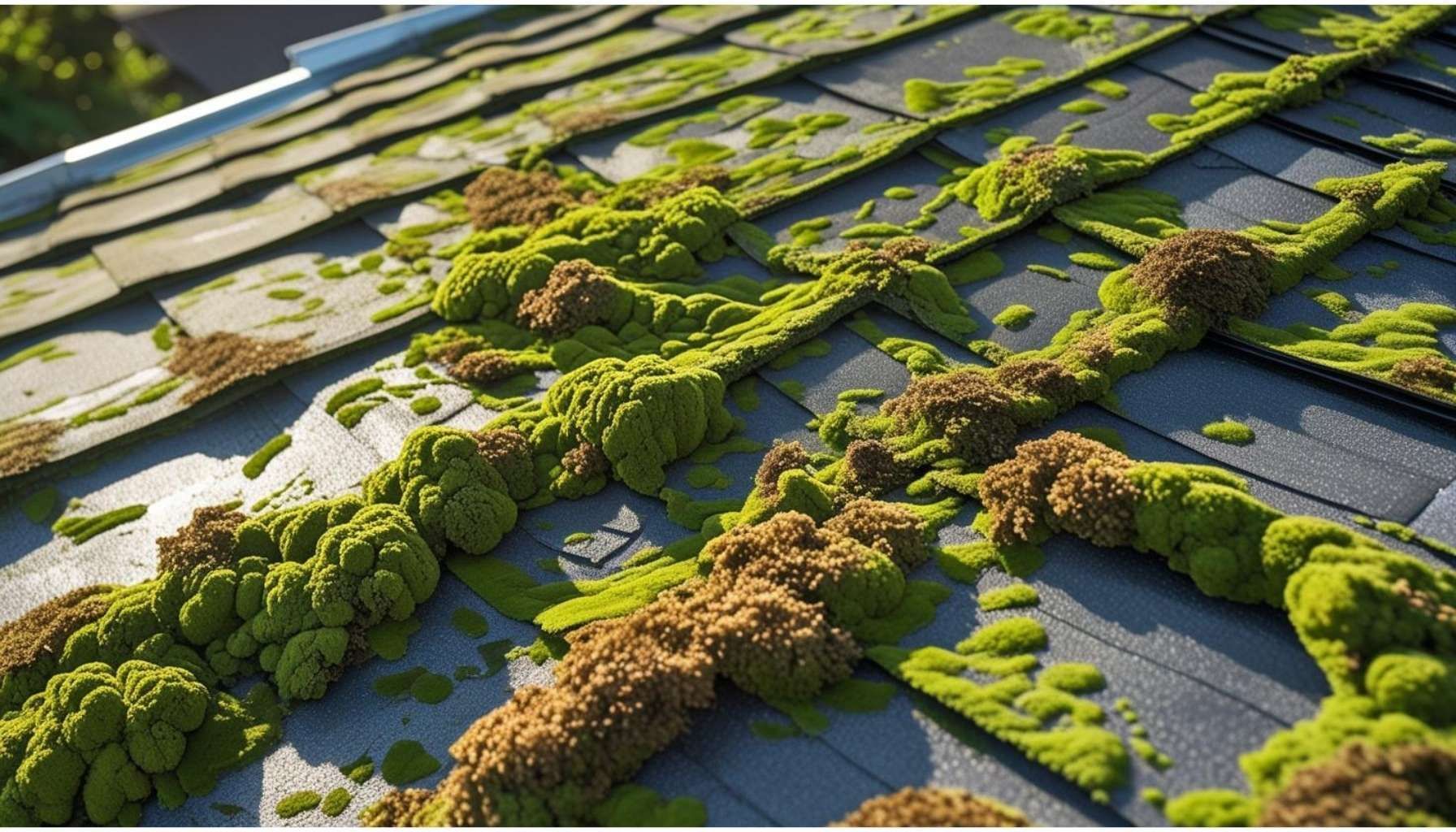
Moss and algae inflict multiple types of damage on roofing systems beyond cosmetic concerns. These organisms create conditions that accelerate material degradation and compromise structural integrity.
Structural Impact on Roofing Materials
Moss and algae affect each roofing material differently. Asphalt shingles suffer when moss lifts protective granules from the surface. This displacement exposes the underlying material to UV rays and weather elements. Gloeocapsa magma algae consume limestone filler in asphalt shingles and weaken the material structure.
Tile roofs experience cracking when moss retains moisture against the surface. The trapped water freezes and expands in cold weather, creating fractures in ceramic and concrete tiles. Algae growth on tiles promotes mold colonies that penetrate porous surfaces.
Metal roofing systems resist moss attachment but face corrosion from acidic algae secretions. The acids eat through protective coatings over 5-10 years. Even galvanized steel and aluminum develop pitting corrosion where algae colonies persist.
Wood shingles absorb moisture from moss mats, leading to rot within 2-3 years of infestation. The constant dampness breaks down wood fibers and creates ideal conditions for fungal decay. Cedar and redwood lose their natural resistance when moss coverage exceeds 30% of the surface area.
Long-Term Effects on Roof Lifespan
Untreated moss and algae reduce roof lifespan by 10-15 years on average. Asphalt shingle roofs rated for 30 years often fail at 15-20 years when moss infestations persist. The accelerated granule loss and moisture damage create premature aging patterns.
Energy costs increase when algae darken roof surfaces. Dark streaks from Gloeocapsa magma raise surface temperatures by 20-25 degrees Fahrenheit. This heat absorption increases cooling costs by 15-20% during summer months.
Repair expenses range from $400-$2,000 for moss and algae damage. Minor repairs involve replacing damaged shingles and treating affected areas. Major repairs include replacing decking boards and addressing structural rot.
Insurance claims related to moss and algae damage often face coverage limitations. Many policies exclude gradual deterioration from organic growth. Homeowners bear full replacement costs when insurers deny claims based on maintenance neglect.
The moisture retention from moss creates wood rot in roof decking. Plywood and OSB boards deteriorate within 18-24 months of sustained moisture exposure. Structural repairs for rotted decking average $3,000-$5,000 per 100 square feet.
Prevention Methods for Moss and Algae
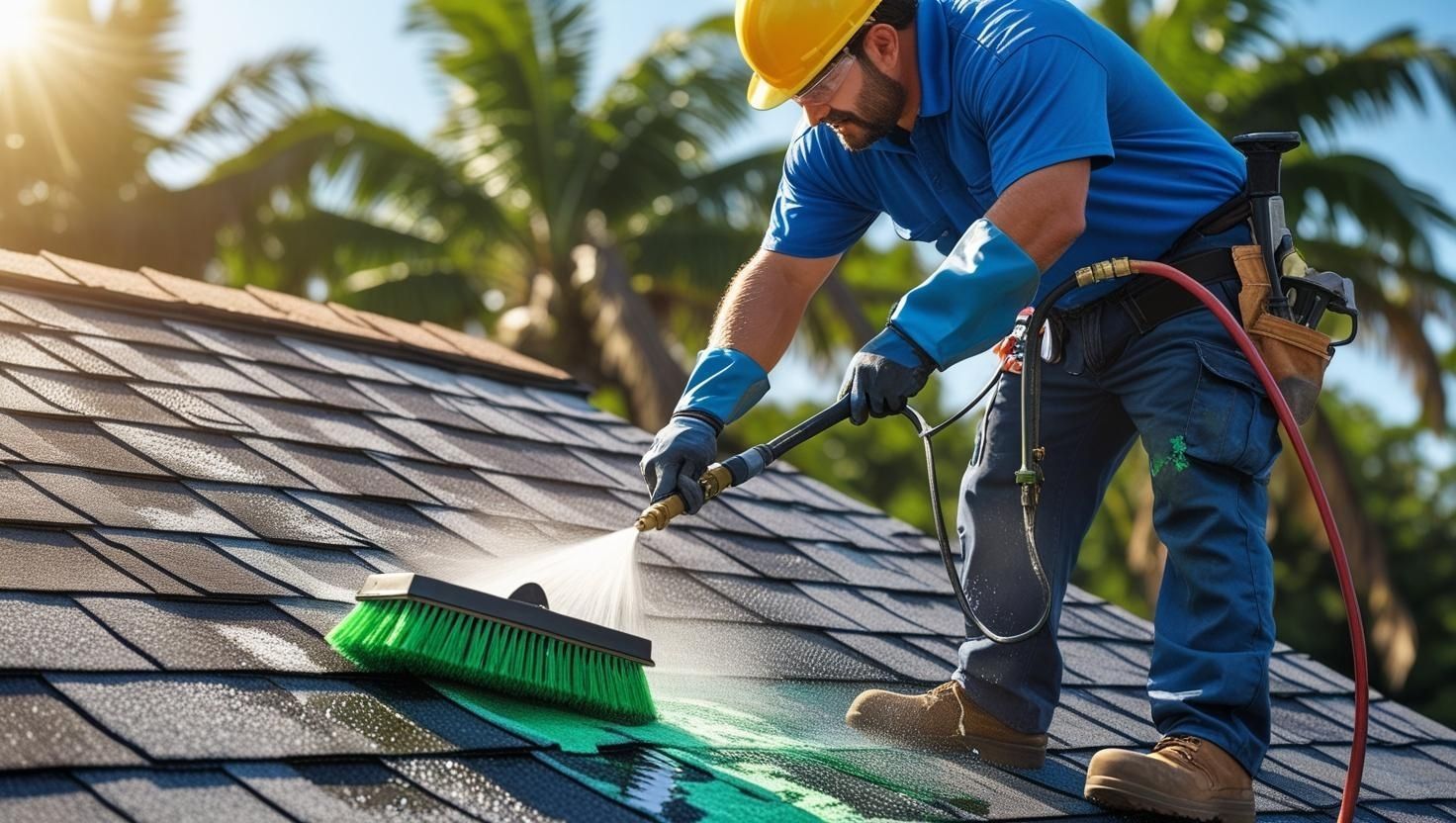
Preventing moss and algae growth on roofs requires proactive measures that address moisture control and environmental factors. We carry out these strategies to protect roof integrity and extend its lifespan by 10-15 years.
Proper Roof Maintenance Practices
We maintain roofs through systematic cleaning and inspection routines that prevent organic growth. Annual professional inspections identify potential moisture problems before moss and algae establish themselves. Inspectors check drainage systems, seal integrity, and shingle conditions during these evaluations.
Gutter cleaning removes debris accumulation twice yearly in spring and fall. Clean gutters ensure water flows away from the roof surface within 24 hours after rainfall. Clogged gutters create standing water that increases moss growth probability by 60%.
Soft washing techniques remove existing growth without damaging roofing materials. We apply biodegradable solutions containing 10% bleach mixed with water and detergents at 40-60 PSI pressure. This low-pressure method preserves shingle granules while eliminating 95% of moss and algae colonies.
Metal strip installation along roof ridges provides long-term protection. Copper strips measuring 2-3 inches wide release ions during rainfall that inhibit organic growth across 15-20 feet of roof surface below. Zinc and galvanized alternatives offer similar protection at 30% lower cost.
Environmental Modifications
We modify roof environments to create conditions unfavorable for moss and algae colonization. Tree trimming increases direct sunlight exposure by 4-6 hours daily on previously shaded sections. Branches hanging within 10 feet of roofs require removal to reduce shade coverage and debris accumulation.
Moisture control starts with proper attic ventilation that maintains humidity levels below 50%. Ridge vents combined with soffit vents create airflow that removes 2-3 gallons of moisture daily from typical residential attics. This ventilation reduces condensation that promotes moss growth on roof undersides.
Drainage improvements direct water away from roof surfaces within minutes after precipitation. We install additional downspouts when existing systems handle less than 600 square feet of roof area per downspout. Splash blocks extend water discharge 4-6 feet from foundations.
Algae-resistant shingles contain copper or zinc granules that provide 15-20 years of protection. These specialized materials cost 10-15% more than standard shingles but eliminate recurring cleaning expenses. Manufacturers warranty these products against algae streaking for minimum 10-year periods.
Removal Techniques and Solutions
Removing moss and algae from roofs requires specific methods that protect both the roofing material and your property. We'll explore effective techniques ranging from DIY approaches to professional services that restore your roof's condition.
DIY Cleaning Methods
DIY moss removal starts with proper preparation and the right tools. We recommend beginning with a garden hose set to low pressure to wet the moss thoroughly. This process loosens the moss's grip on shingles without causing damage.
A soft-bristle brush works best for scrubbing away loosened moss. Start at the roof's peak and work downward to prevent water from seeping under shingles. For persistent moss patches, a putty knife helps remove stubborn growth when used carefully to avoid scraping shingle surfaces.
Chemical solutions offer effective moss-killing properties. Commercial moss removers contain specialized formulas that penetrate moss structures. Homemade alternatives include mixing bleach with trisodium phosphate or creating a 50/50 bleach-water solution. Vinegar mixed with equal parts water also kills moss effectively while being less harsh on surrounding vegetation.
Application timing matters for chemical treatments. Apply solutions during dry weather when rain isn't expected for 24-48 hours. This timeframe allows chemicals to penetrate moss thoroughly before washing away. Avoid pressure washing completely as high-pressure water strips protective granules from asphalt shingles and forces water beneath roofing materials.
Professional Treatment Options
Professional roof cleaning services begin with comprehensive assessments. Technicians evaluate moss coverage extent, identify affected areas, and determine appropriate treatment methods based on roofing material type. This evaluation process ensures customized solutions that protect roof integrity.
Soft washing represents the primary professional technique for moss removal. This method combines low-pressure water application with biodegradable cleaning solutions specifically formulated for roof surfaces. The process kills moss at its root system while preserving shingle condition and manufacturer warranties.
Environmental protection measures distinguish professional services from DIY attempts. Crews install protective barriers around landscaping, redirect chemical runoff away from storm drains, and use eco-friendly products when possible. Professional teams also carry insurance coverage that protects homeowners from liability during treatment processes.
Best Products for Moss and Algae Control
We've identified the most effective products for eliminating moss and algae from roofs. These solutions range from powerful chemical treatments to environmentally conscious alternatives that protect both your roof and surrounding landscape.
Chemical Treatments
Chlorine bleach solutions remain the most effective chemical treatment for roof moss and algae. We recommend mixing liquid chlorine bleach with water in a 50:50 ratio for optimal results. Apply this solution with a pump sprayer and let it sit for 15-20 minutes before rinsing with low-pressure water.
Bleach kills algae within minutes but moss requires patience. Moss loosens gradually over several weeks and often needs 2-3 treatments for complete removal. We suggest using a leaf blower between treatments to remove dead moss without damaging shingles.
Soap-based moss killers like Safer Moss & Algae Killer provide gentler alternatives to bleach. These products clean surfaces while eliminating moss through potassium salts of fatty acids. Apply soap-based treatments directly to affected areas and allow 2-3 hours before rinsing.
Commercial moss killers require protective equipment including gloves, eye protection, and non-slip footwear. Cover plants near the treatment area with plastic sheeting to prevent chemical damage. Schedule applications for calm days to minimize drift and runoff into garden beds.
Eco-Friendly Alternatives
Metal strips offer long-term moss prevention without chemicals. Install copper, zinc, or galvanized strips along the roof ridge to release moss-inhibiting ions during rainfall. These strips protect approximately 15 feet of roof area below their installation point.
Algae-resistant shingles contain copper granules that prevent algae growth for 10-15 years. These shingles cost 10-20% more than standard options but eliminate the need for repeated chemical treatments. Replace existing shingles during your next roof renovation for best results.
Sunlight exposure naturally prevents moss growth. Trim tree branches that shade your roof to increase direct sunlight by 3-4 hours daily. Moss thrives in areas receiving less than 3 hours of sunlight, making shade reduction crucial for prevention.
Regular maintenance eliminates conditions moss needs to grow. Clean gutters quarterly to prevent water backup and remove debris monthly during fall. Install proper attic ventilation to reduce roof moisture levels below 15%, creating an environment hostile to moss and algae growth.
Long-Term Protection Strategies
Long-term protection against moss and algae requires strategic installations and treatments that create hostile environments for organic growth. We recommend combining metal strip systems with protective coatings for comprehensive defense that extends roof lifespan by 10-20 years.
Zinc and Copper Strip Installation
Copper strips provide superior moss and algae prevention through ion release during rainfall. The copper ions act as natural herbicides that inhibit organic growth across 15-20 feet of roof surface. Installation costs range from $5-8 per linear foot for copper strips versus $1.50-3 for zinc alternatives.
We install strips by lifting shingles along the ridge line and sliding 2-3 inch wide metal strips underneath. Proper placement ensures rainwater carries protective ions down the entire roof slope. Copper strips last 20-30 years while zinc strips require replacement every 5-8 years.
Installation steps include:
- Measuring ridge length to calculate material needs
- Lifting every third shingle along the ridge
- Inserting strips with 50% exposure
- Securing with corrosion-resistant nails
- Sealing nail heads with roofing caulk
Copper strips eliminate 95% of moss growth within 6-12 months while preventing new infestations. Zinc strips achieve 70-80% effectiveness but cover smaller areas. Both metals work through oxidation that releases antimicrobial ions during precipitation events.
Protective Coatings and Sealants
Water-resistant coatings create barriers that prevent moisture penetration and reduce surface porosity where moss anchors. We apply acrylic or silicone-based sealants that last 5-10 years depending on product quality and environmental conditions.
Application involves:
- Cleaning roof surfaces to remove debris
- Repairing damaged shingles before coating
- Applying primer to enhance adhesion
- Spraying or rolling protective coating
- Allowing 24-48 hours cure time
We combine coating applications with improved ventilation systems that reduce attic humidity below 40%. Installing ridge vents and soffit vents creates airflow that keeps roof decking dry. This dual approach prevents 90% of organic growth when maintained properly through annual inspections and gutter cleaning.
Conclusion
Protecting your roof from moss and algae growth requires vigilance and proactive care. We've explored how these organisms establish themselves through specific environmental conditions and the serious structural damage they can inflict when left unchecked.
The key to successful roof preservation lies in combining immediate action with long-term protective strategies. Whether you're implementing metal strip systems or scheduling regular professional inspections we've seen that consistent maintenance makes all the difference.
Remember that small investments in prevention today can save thousands in repairs tomorrow. By staying alert to early warning signs and maintaining unfavorable conditions for organic growth you'll ensure your roof remains strong and functional for decades to come.
Your home's first line of defense deserves the attention and care we've outlined throughout this guide. Take action now before minor discoloration becomes major damage.
What causes moss and algae to grow on roofs?
Moss and algae thrive on roofs due to moisture retention, organic debris accumulation, and shaded conditions. Tree coverage, high humidity, and poor ventilation create ideal environments for growth. North-facing slopes and areas under trees are particularly susceptible. These organisms feed on limestone filler in shingles and organic matter that collects on roof surfaces.
How can I identify moss versus algae on my roof?
Moss appears as thick, green carpet-like growth in shaded areas, while algae shows as dark streaks running down roof slopes. Moss has a fuzzy, three-dimensional texture and grows in clumps. Algae (mainly Gloeocapsa magma) creates flat, black or dark green discoloration. Both thrive in moist conditions but have distinct visual characteristics.
What damage can moss and algae cause to my roof?
Untreated growth can reduce roof lifespan by 10-15 years. Moss lifts shingles and traps moisture, causing rot and leaks. Algae strips protective granules from asphalt shingles and secretes acids that corrode metal roofs. Damage includes increased energy costs, structural deterioration, and potential insurance claim denials. Repair costs can range from hundreds to thousands of dollars.
How often should I inspect my roof for moss and algae?
Professional inspections should occur annually, with visual checks every 3-4 months in humid climates. After severe storms or during fall when debris accumulates, additional inspections are recommended. Early detection prevents costly damage. Look for dark streaks, green patches, or lifted shingles as warning signs.
When should I hire a professional versus DIY treatment?
DIY works for early-stage growth covering less than 10% of the roof. Professional help is needed for advanced infestations, steep roofs, or when structural damage is visible. Professionals have proper safety equipment, commercial-grade treatments, and expertise to avoid roof damage. They also identify underlying issues that contribute to growth.
